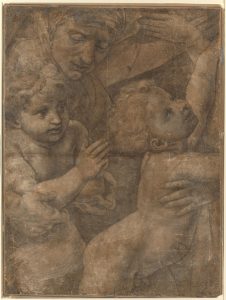Edelinck, Gérard (1640-1707; Flemish/French), after Raphael (1483-1520; Italian)
La Sainte famille de Jesus Christ [The Holy Family] (c.1677)
Engraving
Gift of George Collins Levey, 1879
National Gallery of Victoria (p.183.34-1)
= Levey gift, cat.no.7
Here, the engraver seen as the greatest printmaker of Louis XIV’s era reproduced (in reverse) the famous Madonna of François I. The commission was arranged through Le Brun, and the print, “widely considered Edelinck’s masterpiece” (Véronique Meyer), was fundamental to the printmaker’s later success (for details, see linked artist entry).
The original painting was a gift to French king François I from Pope Leo X in 1518 (see also Rousselet after Raphael St Michael defeating the Devil {1879} NGV [PR]). Regarded throughout the Renaissance and Baroque periods as by Raphael himself, the Louvre painting is now recognized as largely the work of his principal assistant Giulio Romano (c.1499-1546), a fragment of whose chalk cartoon for the figures of St Elizabeth, St John and the Infant Christ is in the NGV (Howard Spensley Bequest 1939): see reproduction below.

Refs.
Not listed in NGV 1894 or 1905
See https://www.ngv.vic.gov.au/explore/collection/work/38121/ (not reproduced; as by an unknown engraver). For a detailed recent account of this print, see Fuhring Kingdom of Images (2015), cat.48, pp.158-59 (entry by Véronique Meyer, as quoted above); see also Suite et arrangement (1727), 1; Duplessis Cabinet du roi (1869), p.7 (noting a payment of 1200 livres to Edelinck on 12 Dec.1677); and http://catalogue.bnf.fr/ark:/12148/cb42028557f. There is a good impression in the British Museum, acquired in 1868: https://www.britishmuseum.org/collection/object/P_1868-0822-965 (with reproduction)
For the painting in Paris, see Louvre cat.II (1981), p.221, Inv.604 (noting that the commission was arranged by Lorenzo de’Medici, ambassador to the French court)
For the NGV drawing, including good reproductions, see Sonia Dean, Master Drawings from the collection of the National Gallery of Victoria (1986), pp.26-27 (noting that another fragment is held in Bayonne); and https://www.ngv.vic.gov.au/explore/collection/work/39035/ (as reproduced above)

